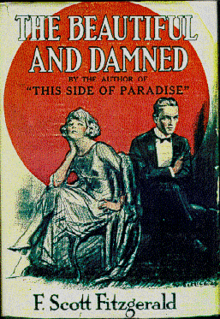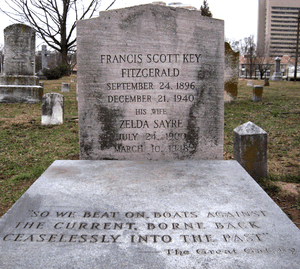The Beautiful and Damned
 The first edition cover with the characters of Anthony and Gloria drawn to resemble Fitzgerald and Zelda[lower-alpha 1] | |
| Author | F. Scott Fitzgerald |
|---|---|
| Country | United States |
| Language | English |
| Genre | Novel |
| Publisher | Charles Scribner's Sons |
Publication date | 1922 |
| Media type | Print (Hardback & Paperback) |
| Preceded by | This Side of Paradise (1920) |
| Followed by | The Great Gatsby (1925) |
The Beautiful and Damned, first published by Scribner's in 1922, is F. Scott Fitzgerald's second novel. It explores and portrays New York café society and the American Eastern elite during the Jazz Age before and after "the Great War" and in the early 1920s.[1][2] As in his other novels, Fitzgerald's characters in this novel are complex, especially with respect to marriage and intimacy. The work is generally considered to have drawn upon and be based on Fitzgerald's relationship and marriage with his wife Zelda Fitzgerald.[1][2]
Plot summary
The Beautiful and Damned tells the story of Anthony Patch, a 1910s socialite and presumptive heir to a tycoon's fortune, and his courtship and relationship with his wife Gloria Gilbert. It describes his brief service in the Army during World War I, and the couple's post-war partying life in New York, and his later alcoholism.[1][3] Gloria and Anthony’s love story is much more than just a couple falling in love. Their story deals with the hardships of a relationship, especially when each character has a tendency to be selfish. Joanna Stolarek suggests, Fitzgerald draws on “Zelda, the object of the writer’s literary passion” (Stolarek et al. 53).[4]
Toward the end of the novel, Fitzgerald sums up the plot and his intentions in writing it somewhat, even referencing his own first novel, when a financially successful writer friend tells Anthony:
- "You know these new novels make me tired. My God! Everywhere I go some silly girl asks me if I've read 'This Side of Paradise'. Are our girls really like that? If it's true to life, which I don't believe, the next generation is going to the dogs. I'm sick of all this shoddy realism. I think there's a place for the romanticist in literature."[5]
Characters
Anthony Patch: He is an heir to his grandfather’s large fortune, and is unmotivated to work, though he tries various careers. He is entranced by Gloria and falls hopelessly in love with her, completely taken aback by her beauty. He is drafted into the army but does not see active service. Throughout the novel he compensates for a lack of vocation with parties and increasing alcoholism. His expectations of future wealth make him powerless to act in the present.
Gloria Gilbert: A beauty who takes Anthony’s heart, breaking a heart or two along the way. She is a socialite but entertains notions if becoming an actress. Gloria is self-absorbed but loves Anthony. Her personality revolves around her beauty and a, not unjustified, belief that this makes her more important than everyone else. She simultaneously loves Anthony and hates him. Like Anthony she is incapable of being an agent in the present. In Gloria's case it is because she cannot imagine a future beyond her first flower of beauty.
Richard “Dick” Caramel: Richard is an aspiring author, and is one of Anthony’s best friends. During the course of the book he publishes his own novel, The Demon Lover, and basks in his glory for a good amount of time after publication. He is Gloria’s cousin and is the one who brought Anthony and Gloria together.
Mr. Bloeckman: Bloeckman is a movie producer who is also in love with Gloria, and hopes she will leave Anthony for him. Gloria and Bloeckman had a relationship in the works when Gloria and Anthony were introduced. He is a friend of the family, but Gloria falls for Anthony instead. He continues to be friends with Gloria, giving Anthony some suspicion of an affair.
Dorothy “Dot” Raycroft: Dorothy is the woman that Anthony has an affair with while training for the army. She is a lost soul looking for someone to share her life with. She falls in love with Anthony despite learning that he is married, causes problems between Gloria and Anthony, and leads to decline in Anthony's mental health.
Themes

The Beautiful and Damned is, at once, a morality tale, a meditation on love, money and decadence, and a social documentary. It concerns the characters' disproportionate appreciation of and focus on their past, which tends to consume them in the present.[3] The theme of absorption in the past also continues through much of Fitzgerald's later works, perhaps best summed up in the final line of his 1925 novel, The Great Gatsby: "So we beat on, boats against the current, borne back ceaselessly into the past", which is now also inscribed on Fitzgerald's tombstone shared with Zelda in Maryland.[1]
According to Fitzgerald critic James West, The Beautiful and Damned is concerned with the question of 'vocation'—what does one do with oneself when one has nothing to do? Fitzgerald presents Gloria as a woman whose vocation is nothing more than to catch a husband. After her marriage to Anthony, Gloria's sole vocation is to slide into indolence; her husband's sole vocation is to wait for his inheritance, during which time he slides into alcoholism.[6]
Publication history
Fitzgerald wrote The Beautiful and Damned quickly in the winter and spring of 1921–22, while Zelda was pregnant with their daughter,[2] following editorial suggestions from his friend Edmund Wilson and his editor Max Perkins.[1] Chapters of the book were first serialized in Metropolitan Magazine in late 1921, and in March 1922 the book was published. Based on the credible sales of his first book, This Side of Paradise, Scribner's prepared an initial print run of 20,000 copies, and mounted an advertising campaign. It sold well enough to warrant additional print runs reaching 50,000 copies.[1]
Fitzgerald dedicated the novel to the Irish writer Shane Leslie, George Jean Nathan, and Maxwell Perkins "in appreciation of much literary help and encouragement".[7]
Originally called by Fitzgerald The Flight of the Rocket as a working-title, he had also divided it pre-publication into three major parts: "The Pleasant Absurdity of Things", "The Romantic Bitterness of Things", and "The Ironic Tragedy of Things".[1] As published in book form, however, it consists of three, untitled "Books" of three chapters each:[8]
- Book One
- 1. – Anthony Patch
- 2. – Portrait of a Siren
- 3. – The Connoisseur of Kisses
- Book Two
- 1. – The Radiant Hour
- 2. – Symposium
- 3. – The Broken Lute
- Book Three
- 1. – A Matter of Civilization
- 2. – A Matter of Aesthetics
- 3. – No Matter!
The first book tells the story of the first meeting and courtship of a beautiful and spoiled couple, Anthony and Gloria, madly in love, with Gloria estatically exclaiming: "mother says that two souls are sometimes created together—and in love before they're born."[9]
Book two covers the first three years of their married life together, with Anthony and Gloria vowing to adhere to,
- "The magnificent attitude of not giving a damn...for what they chose to do and what consequences it brought. Not to be sorry, not to lose one cry of regret, to live according to a clear code of honor toward each other, and to seek the moment's happiness as fervently and persistently as possible."[10]
The final book recounts Anthony's disinheritance, just as the U.S. enters the "World War I"; his year in the Army while Gloria remains home alone until his return; and the couple's rapid, final decline after the War into alcoholism, dissolution and ruin – "to the syncopated beat of the Jazz Age".[1]
At the end, Anthony Patch shows some of the same revisionism as his grandfather in the opening chapter, describing his great wealth as a necessary consequence of his character rather than to circumstance. Fitzgerald writing in the closing lines of the novel:
- "Only a few months before people had been urging him to give in, to submit to mediocrity.... But he had known that he was justified
in his way of life—and he had stuck it out staunchly.... 'I showed them ... It was a hard fight, but I didn't give up and I came through!"[11]
- "Only a few months before people had been urging him to give in, to submit to mediocrity.... But he had known that he was justified
Reception
Louise Field, writing in The New York Times, found the novel showed Fitzgerald to be talented, but labeled him too pessimistic. She said she hoped he "will some day acquire a less one-sided understanding".[12]
Adaptations
A film adaptation in 1922, directed by William A. Seiter, starred Kenneth Harlan as Anthony Patch, and Marie Prevost as Gloria.[13]
There is a French and a German translation.[14]
In 2016 a new adaptation was announced. The full cast has not been announced, except Scarlett Johansson, who will be playing the author's wife, Zelda.[15]
Notes
- ↑ A 2013 paperback edition cover uses a photograph of Tallulah Bankhead, a great friend of Zelda's, as Gloria Gilbert. (Scribner's, March 2013. ISBN 9781476733425
References
- 1 2 3 4 5 6 7 8 Bruccoli, Matthew J. – Some Sort of Epic Grandeur: The Life of F. Scott Fitzgerald, Carroll & Graf, New York, 1992.
- 1 2 3 Milford, Nancy – Zelda: A Biography, Harper & Row, New York, 1970.
- 1 2 Perosa, Sergio (1965). "The Beautiful and Damned". The Art of F. Scott Fitzgerald. Ann Arbor: The University of Michigan Press. LCCN 65-11463.
- ↑ Stolarek, Joanna, et al. "The Beautiful and Damned – The Influence of Zelda Fitzgerald on F. Scott Fitzgerald's Life and Literary Output." Muses, Mistresses, and Mates: Creative Collaborations in Literature, Art and Life. Cambridge Scholars Publishing, 2015. Print.
- ↑ Fitzgerald, F. Scott – The Beautiful and Damned, Charles Scribner's Sons, New York, 1922 – pg. 421.
- ↑ James West – The Perfect Hour: The Romance of F. Scott Fitzgerald and Ginevra King, Random House, New York, 2005, pg. 48–51.
- ↑ The Beautiful and Damned, p. iv.
- ↑ The Beautiful and Damned, p. v.
- ↑ The Beautiful and Damned, p.131.
- ↑ The Beautiful and Damned, p.226.
- ↑ The Beautiful and Damned, p.449.
- ↑ Maunsell Field, Louise (March 5, 1922). "Latest Works of Fiction". The New York Times.
- ↑ Seiter, William. "The Beautiful and Damned (1922)". The New York Times.
- ↑ Winters, Marion (2004). "German Translations of F. Scott Fitzgerald's The Beautiful and Damned. A Corpus-based Study of Modal Particles as Features of Translators' Style". In Kemble, Ian. Using Corpora and Databases in Translation: Proceedings of the Conference Held on 14th November 2003 in Portsmouth. London: University of Portsmouth. pp. 71–89. ISBN 1861373651.
- ↑ "Scarlett Johansson set to play F. Scott Fitzgerald's flapper wife Zelda in movie about her rocky relationship with the author".
Sources
- West, James L. W., III (2002). "The Question of Vocation in This Side of Paradise and The Beautiful and Damned". In Prigozy, Ruth. The Cambridge Companion to F. Scott Fitzgerald. Cambridge, UK: Cambridge University Press. pp. 48–56. ISBN 0-521-62447-9.
External links
| Wikisource has original text related to this article: |
- The Beautiful and Damned at Project Gutenberg E-text.
- The Beautiful and Damned, available at Internet Archive, scanned book. (New York: Charles Scribner's Sons, 1922).
-
 The Beautiful and Damned public domain audiobook at LibriVox
The Beautiful and Damned public domain audiobook at LibriVox